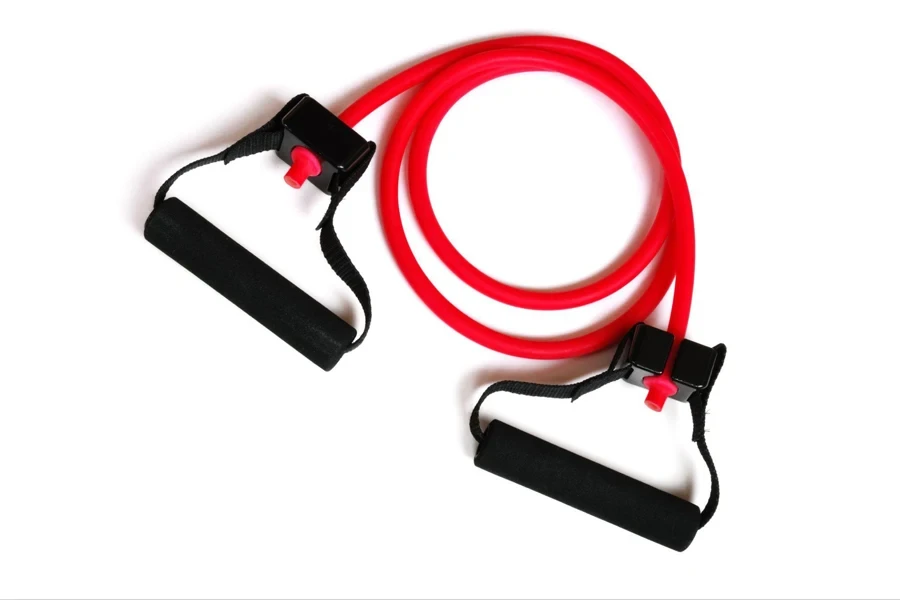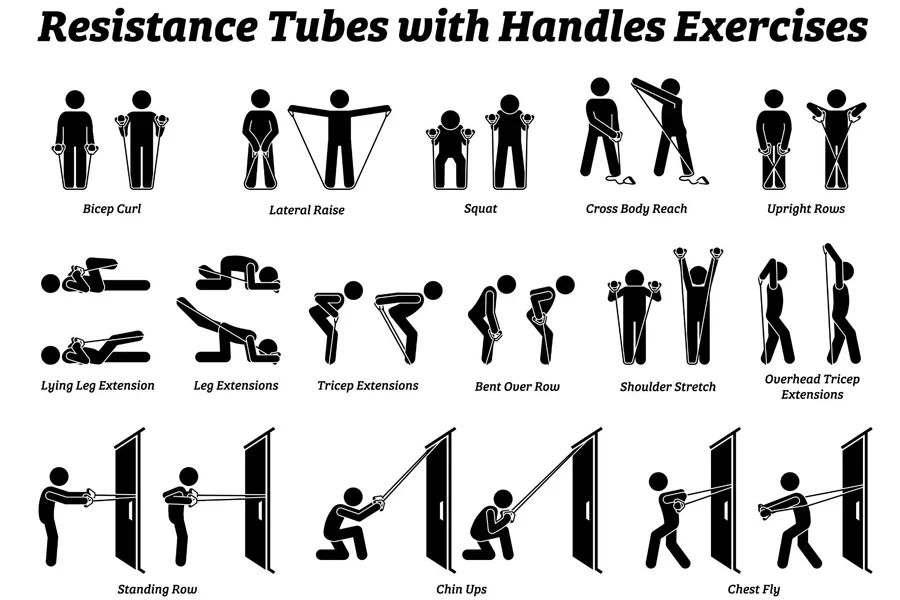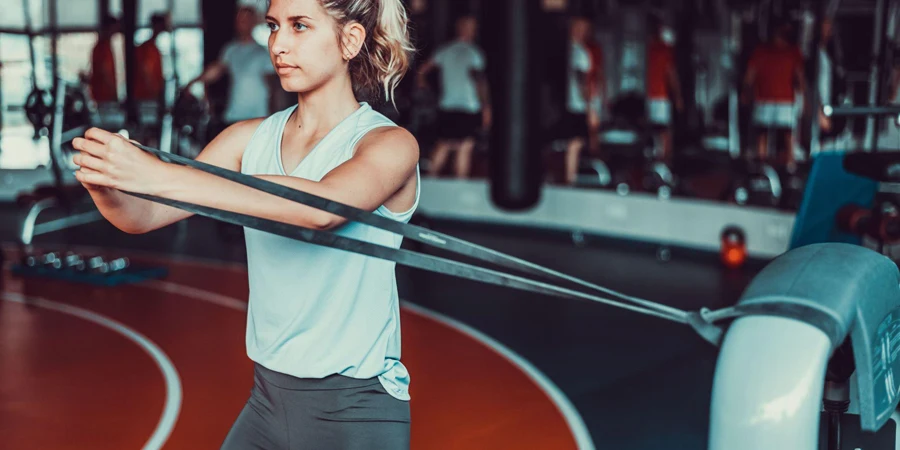Table of Contents
● Introduction
● Exercise Bands Market Overview
● Key Considerations of Selection
● Conclusion
Introduction
In the ever-evolving world of fitness, exercise bands have emerged as indispensable tools for both beginners and seasoned athletes. Their versatility, affordability, and effectiveness in enhancing workouts make them a must-have in any fitness regimen. This guide delves into the critical aspects of selecting the best exercise band to meet your customers’ fitness goals, ensuring business professionals and online retailers help the consumers make informed decisions that complements their workout routine.
Exercise Bands Market Overview
The exercise band market has witnessed substantial growth, fueled by a surge in awareness regarding physical health and the convenience of home workouts. As of 2023, the global market size for exercise bands is estimated at USD 1.2 billion, with projections to reach USD 1.6 billion by 2029, reflecting a Compound Annual Growth Rate (CAGR) of approximately 5%. This growth is attributed to the bands’ adaptability across various fitness levels and their application in strength training, rehabilitation, and flexibility exercises. The market is characterized by a wide array of products, from latex and fabric bands to those with adjustable resistance levels, catering to a diverse consumer base seeking personalized fitness solutions.

Key Considerations of Selection
Material and Durability
Latex Resistance Bands: Elasticity Meets Durability
Latex resistance bands are celebrated for their exceptional elasticity and robust durability, making them a preferred choice for a wide range of fitness routines. With proper care, including regular cleaning and appropriate storage, latex bands can serve users for years. Typically, these bands can last from 2 to 5+ years for home workouts and 6 months to 3+ years in a gym setting, depending on usage frequency and intensity. To maximize their lifespan, it’s essential to avoid overstretching the bands, shield them from direct sunlight, and store them in a cool, dry environment.
Non-Latex Resistance Bands: A Safe Alternative for Allergy Sufferers
Non-latex resistance bands, crafted from synthetic rubber materials, offer a safe and effective workout option for those with latex allergies. These bands maintain versatility across various exercises, including stretching, mobility drills, and resistance training. Available in multiple resistance levels, often denoted by color coding, non-latex bands cater to a broad spectrum of fitness activities without compromising on performance.
Fabric Bands: Enhancing Comfort in Workouts
Fabric resistance bands, known for their comfort and reduced risk of rolling or pinching, provide a user-friendly alternative to traditional rubber bands. Constructed from materials such as nylon or a blend of fabric and latex, these bands combine durability with a gentle touch, making them ideal for exercises that require bands to be placed around the legs or hips. The unique composition of fabric bands ensures both longevity and a pleasant exercise experience, particularly for lower body workouts.

Resistance Levels
Varied Resistance Bands: Color-Coded for Progression
Resistance bands come in various resistance levels, which are often color-coded to help users identify the level of resistance offered by each band. TheraBand is one of the brands that uses a color sequence to indicate the resistance levels of their bands:
Yellow: 1-6 pounds of resistance (lightest)
Red: 2-7 pounds of resistance (light)
Green: 2-10 pounds of resistance (light-medium)
Blue: 3-14 pounds of resistance (medium)
Black: 4-18 pounds of resistance (heavy)
Silver/Gold: 10-40 pounds of resistance (heaviest)

There is approximately a 20-30% increase in resistance between TheraBand colors at 100% elongation. This allows users to select a band that matches their current fitness level and progress to bands with higher resistance as they get stronger.
Adjustable Resistance Bands: Tailored Resistance on Demand
Adjustable resistance bands, such as the Gaiam Adjustable Hip Bands, offer a dynamic solution for varying workout intensities without the need for multiple bands. These bands typically feature mechanisms like buckles, hooks, or clips, allowing users to easily modify the length—and thereby the resistance—of the band to suit different exercises and training levels. This adaptability makes adjustable bands particularly useful for progressive strength training and rehabilitation, providing a tailored workout experience.
TheraBand’s Trusted Progression™ System
TheraBand stands out with its Trusted Progression™ System, which extends beyond mere color coding to a meticulously tested and validated system of resistance levels. This system ensures that each band, whether latex or non-latex, delivers consistent resistance, allowing clinicians and users alike to have confidence in the progression of their recovery or fitness journey. TheraBand’s commitment to quality and performance is evident in their extensive range of products, from traditional latex and non-latex bands to innovative CLX bands and high-resistance options, catering to a wide array of fitness and therapeutic needs.
Resistance Bands Dimension
Length: Optimal for Versatility and Specific Exercises
The standard length for heavy-duty loop resistance bands, ideal for a range of activities from warming up and mobility to strength training, is 41 inches. This length is considered optimal for versatility, allowing for large movements and a variety of exercises. However, there are variations like shorter mini loop bands for targeted lower body workouts and longer bands for specific athletic training, such as resisted sprints. The uniform 41-inch length across different resistance levels ensures consistency in exercise execution, with the width of the band determining the resistance level.
Width: Dictating Resistance and Stability
The width of resistance bands significantly influences their resistance level and stability during use. Bands typically range from .25 inches to 2.5 inches in width, with the resistance increasing as the bands get wider. For example, a 1/4″ band offers 5-15 pounds of resistance, suitable for stretching and light resistance exercises, while a 2 1/2″ band provides a hefty 60-170 pounds of resistance, ideal for large muscle group training and heavy compound exercises. Wider bands are less prone to rolling up, offering a more stable and comfortable workout experience.

Safety Features
Anti-Snap Technology: When selecting resistance bands, opt for those that incorporate Anti-Snap Technology, which may include a cord or fabric running through the band to prevent it from snapping if overstretched. This feature is crucial for ensuring safety during intense workouts, as it minimizes the risk of injury from a sudden band breakage.
Comfortable Grips: Ensure that the resistance bands you choose have comfortable and secure grips, whether they are handles or loops. This is essential to prevent slipping or discomfort during exercise, which can lead to improper form and potential injury. Comfortable grips also enhance the overall workout experience, allowing for longer and more effective sessions.

Portability and Versatility
Compact and Lightweight Design: Resistance bands are perfect for on-the-go workouts due to their compact size. Ideal for travelers or those with limited space, they fit easily in small storage areas, ready for use anytime.
Carrying Cases for Convenience: Many sets include carrying cases, enhancing ease of transport and organization, safeguarding the bands from damage when not in use.
Stackability for Increased Resistance: Unique to resistance bands is the ability to stack them for adjustable resistance levels, accommodating a broad spectrum of exercises and fitness levels without extra equipment.
Additional Features
Door Anchors: Allow for a variety of pulling and pushing exercises by securing the band at different heights.
Ankle Straps: Enable a range of leg and glute exercises, adding intensity to lower body workouts.
Workout Guides: Offer structured routines and tips to get the most out of your resistance band workouts, ideal for beginners or those seeking new challenges.
Online Resources: Access to video tutorials or online classes can significantly enhance your training by providing visual guidance and advanced workout routines.

Conclusion
Selecting the right exercise band is more than just a purchase; it’s an investment in the health and fitness journey. By considering the key factors outlined in this guide, you can find a band that not only meets your customers’ current fitness needs but also grows with them. Remember, the best exercise band is one that is durable, versatile, and aligns with your workout goals, ensuring you get the most out of every session.




